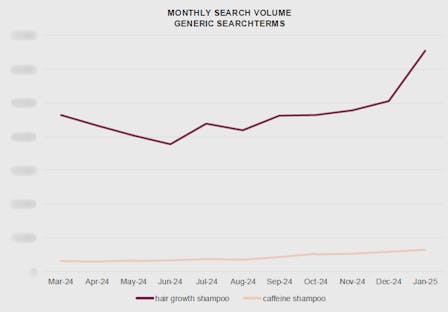Which Keywords Are Your Competitors Overlooking?
How do you compete on Amazon without burning through budgets on expensive search terms? The answer sometimes lies in the details, specifically in the ingredients customers already value.
At Front Row, we recently tackled this very challenge with a global beauty and healthcare company already seeing strong performance in the US oral care market. Consumers weren’t just buying their toothpaste – they were actively searching for the hydroxyapatite ingredient it contained.
Building on that success, we sought to apply the same ingredient-focused approach to the company’s niche haircare products. However, given that the rise in popularity of ingredient searches was influenced by broader market trends and external factors, we wondered:
Would ingredient-based marketing resonate with haircare consumers in the same way?
Identifying the Hidden Opportunity
The US hair regrowth category on Amazon is booming, growing by 52% year-over-year in early 2025. But despite this growth, our client’s two niche haircare brands were relatively new to the US market, operating with limited to zero brand awareness and facing strong category incumbents.
Our mission was to assist the client in reaching their ambitious sales targets without proportional increases in advertising spend. To achieve this, we recommended a strategic rethink, based on how we would approach it if it were our own brand. Our research led us to identify a promising, yet underutilized opportunity: ingredient-based searches.

The Ingredient Factor
In our research, we clustered Amazon consumers in the beauty, health, and wellness sectors into three categories based on their search behavior:
- Problem Solvers: Shoppers searching broadly for generic solutions like "hair loss shampoo" or "shampoo for thinning hair." These searches are highly competitive, expensive, and often dominated by well-established brands.
- Scientific Advocates: Shoppers actively searching for specific ingredients they know and trust. In our client’s case, the key ingredient was caffeine, scientifically supported for its hair growth benefits.
- Brand Enthusiasts: Shoppers searching directly for specific brands they already recognize and trust. These searches typically reflect higher brand awareness and lead to better conversion rates for established brands.
Through search behavior analysis using Amazon's reporting tools, we noticed that:
1. Generic search terms were highly competitive and costly, often prohibitively so for sustained growth.
2. Ingredient-focused searches, particularly "caffeine shampoo," had notably lower CPCs. Yet, conversion rates nearly matched those of branded searches.
This was a clear signal that while "caffeine shampoo" had lower search volumes compared to other generic terms, these searches were more targeted, cost-effective, and crucially, held untapped growth potential.

Educating and Converting Ingredient-Aware Customers
To capitalize on this, we recommended a multi-layered marketing strategy specifically designed around the ingredient caffeine, emphasizing its scientifically backed haircare benefits.
- SEO & Sponsored Ads Strategy: We recommended focusing on caffeine-related keywords, with the goal of securing high visibility in search results at lower CPCs and strong ROAS. We also suggested shifting budgets away from high-cost, low-return generic terms.
- Content & Education: We advised utilizing both Amazon Affiliate and Influencer Networks to create compelling educational content. Influencers could explain caffeine’s scientific benefits through relatable and authentic user-generated content (UGC), boosting consumer trust and curiosity.
- Cross-Channel Amplification: To build broader awareness, we also advised on using off-Amazon activities such as influencer partnerships and targeted digital campaigns. These efforts could reinforce caffeine’s benefits while driving consistent message recall across platforms like DSP and video.

Realistic Budgets, Ambitious Results
To align expectations with strategic planning, we developed media investment scenarios that helped the client understand different potential outcomes – from conservative, profitability-focused models to more growth-driven forecasts. This provided a clear view of what level of investment would be needed depending on the client's goals, guiding decisions on resource allocation and campaign design.
Ultimately, the best strategy lay in the middle: strategically shifting resources to high-return, ingredient-based marketing, supported by targeted off-Amazon campaigns.

Transforming Insights into Action
For brands facing intense competition and limited brand awareness, ingredient-based marketing can be transformative. It allows challenger brands to sidestep costly competition, creating profitable niches around scientifically backed, consumer-valued ingredients.
At Front Row, turning these insights into results is our specialty. Whether your challenge is breaking through the noise, effectively managing media spend, or clearly positioning your brand in a crowded market, the solution might be closer than you think, hidden in the ingredients your consumers already trust.
Curious about how ingredient-based marketing could boost your Amazon strategy? Let’s talk.
